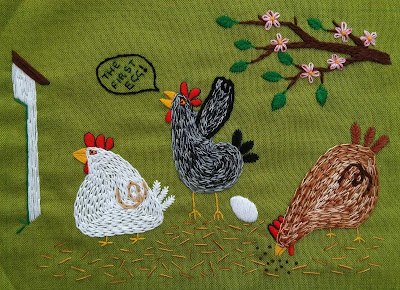This was a fun project set by Jennifer Collier as part of the Textileartist.org free Community Stitch Challenges that ran over the past 3 weeks. I didn't have time to do the earlier 2 but this one really grabbed my attention! My piece involves a technique called cathedral windows but Jennifer also covered making paper roses, paper suffolk puffs, paper patch pockets and Rouleau loops.
If you search for cathedral windows quilts online you will see hundreds of lovely quilts, typically all made in a single colour fabric, traditionally white or cream but also stunning in black and denim, with the colour coming from the diamonds in between each block. The revelation here was to try making them out of paper in exactly the same way.
A quilter might start with a Jelly roll of fabric. I started with the paper equivalent - a 6" square block of co-ordinating scrapbook papers, that I have had for ages. Jennifer used maps, used paper and packaging and sweet wrappers in her demonstration piece so anything is worth a try!
You start by accurately folding the corners in to the centre all the way round.
Then repeat, again folding the corners forwards over the last set of folds.
Fold some more and then work out the order of your design. I went for a dark to light effect for my sample.
Next take pairs of the folded squares and stitch together using a running stitch. Jennifer recommends pre-pricking the holes so as not to tear the paper but I found it fine without as my paper was thicker. The stitching will be hidden so you can use a simple darning knot to start the thread off. I used double thickness of ordinary machine cotton. I made 3 strips of 3 and then could sew them together down the long side to form the 3x3 design.
I then made 2 templates out of cereal box card. One is a petal shape so I can cut out contrasting coloured petals to put under some of the windows. The second is the template for the diamond shape to fit in between the blocks - this has a curved edge so that I can use it as a scoring template for the paper and cut away the edge of the diamond so it fits neatly.
You have to fix the petals in before you create the windows so it is a bit of guess work to create a design that you can't really see the full effect of until the end. This was a sample so I went with a full set of petals on a couple and single or double petals on the others.
I used chocolate wrappers - paper and foil - old serviette, tissue paper, brown paper packaging and coloured paper. They were all stuck down with glue stick. Then I pre-pricked the hols to make a cross stitch in the centre of each block to hold them down - I used a needle onto old corrugated cardboard to do this. Each cross is just knotted off at the back but you do want them quite firm. Next I used my diamond template to score a curved line along each folded edge with the eye end of a large needle. The window can then be carefully bent back to reveal the petals underneath. This was quite fiddly and I did rip the paper in a couple of places.

Then I had fun cutting out the diamonds to sit in between. It felt a shame to cover up the lovely patterns underneath, but I could see that they did make the whole piece more interesting and also cover up the joins. I left a few uncovered around the edge. Aside from scrapbook papers I used chocolate foil and wrappers, brown paper bag, cellophane and serviette. When I was happy with my design I stuck them down with glue stick.
Finally I had to stick down the folds around the windows. Glue stick wasn't up to it so I used PVA and applied it with a paint brush, holding down each fold with a paper clip to help it dry flat.
I am very pleased with the end result and can see that this would make a lovely larger piece of art for the wall - especially as you can buy the scrapbook paper blocks in loads of different co-ordinating designs and colours and then mix in your own found papers to really make it personal and special.
























































